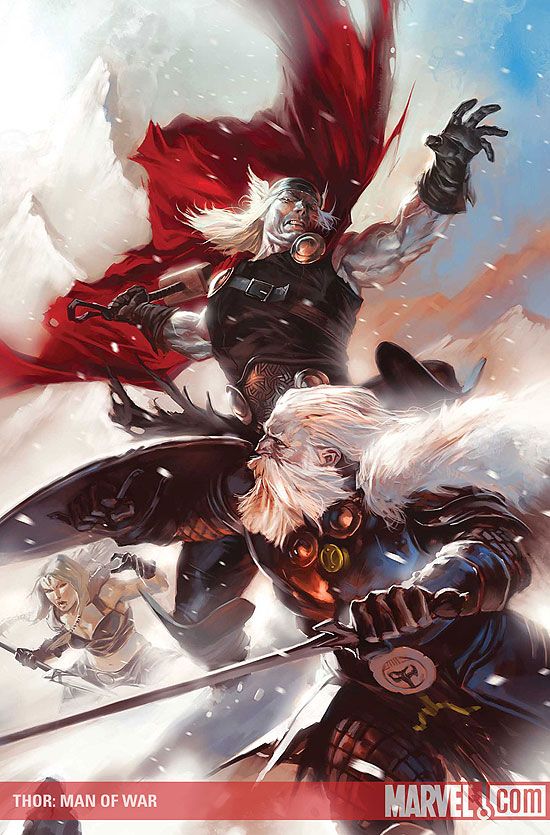The third "Thor" one-shot by Matt Fraction completes the story of Thor's pride getting the best of him after watching those around him screw up and then demand his help only to be betrayed in "Reign of Blood," when a group of humans ate his horses. Fraction tries to balance the justified anger Thor has with his disproportionate response, which is to go on a rampage across all of creation.
The language used to describe Thor's response usually refers to it as a tantrum or the actions of a spoiled brat, placing Thor in a role we're not used to: the impetuous youth in good need of a smack. His father, Odin, is more than happy to oblige, first sending out the Valkyrior and then confronting Thor himself. There's a certain joy to be had in seeing Thor get taught a lesson in humility at the hands of his father.
At the same time, Fraction has built up the incompetence of Odin and the other Asgardians to such proportions that Thor's arguments have merit and his ultimate lesson in humility seems unjust. In the previous two one-shots, the Asgardians and humans have been equally guilty of pride and foolishness, but have been able to turn to Thor for assistance. In a way, the question implied here is one of Thor's justification for lacking humility, which he would have a good argument for.
Ultimately, the conflict here is really between young and old with each blind to their own faults, which Fraction captures wonderfully. Thor sees his pride and rage as justified, unable to see how over-the-top his reaction is, while Odin sees his role as All-Father as a free pass to behave however he wants, unable to see that he has made foolish mistakes and is just as prideful as Thor. That most of this goes unsaid directly is a very smart choice on Fraction's part.
His use of narration is a great mix of a more formal tone to convey the epic nature of the stories, and modern language to avoid the pseudo-Shakespearian style Thor has had up until recently. Fraction also, wisely, allows artists Clay Mann and Patrick Zircher tell much of the story through their differing yet compatible styles. Mann's line-work is very fine and resembles Olivier Copiel's art on "Thor," acting as a great visual allusion to the main title.
Zircher's art is much more reminiscent of Barry Windsor-Smith's work, giving his half of the book an older, more mythic feel. His depiction of the fight between Thor and Odin not only looks, but feels, larger-than-life, the way a battle between two of the most powerful gods should feel. He uses horizontally long panels to suggest a "widescreen" style that really works. Since he also illustrated a story in the previous two specials, Zircher's art is also a stabilizing factor in many ways along with Fraction's writing.
Reading the first two specials isn't necessary, as everything you need to know is here as Matt Fraction and company deliver a pair of stories illustrating an immature Thor sorely in the need of a lesson, even if it's from a hypocritical father. The ending will seem very familiar to any fan of the character and works well with the idea of the Asgardians living through numerous life cycles.
(Check out some of https://www.comicbookresources.com/?page=preview&id=1444" target="_blank">the gorgeous art in CBR's preview!)

